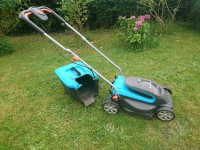DIY Lawn mower robot

Construction and development of a powerful and sustainable lawn mowing robot without boundary wire based on old battery lawn mowers, used PC components, cameras, LIDAR & GPS system plus ultrasonic sensors.
Requirements:
The self-sufficient robotic lawnmower should be as affordable as possible and also sustainable from existing or second-hand purchased components. Final price should be under 500 euros.
It should get along without boundary cables that are laid in the ground.
It must be able to mow three lawns, which are present with our house, and thereby the stone slab ways around the house and detect independently before collision by means of radar, ultrasonic sensor or lidar,
whether there is an obstacle in the way and interact with it.
Obstacles on the lawn must also be detected and avoided: Deer, cat, dog, birds, (snails & frogs), individual bushes, bath tub, garden swing, etc. It should be able to learn by means of an AI system and be remotely controllable without a separate cell phone connection via an integrated web server from a cell phone or PC. from a mobile phone or PC without a separate mobile phone connection. Software updates and updates are to be synchronized via WLAN.
When the battery level is low, the device should move to its charging garage in good time.
It should be avoided to use components from Chinese production.
Planning and Experiental Setup
First, I got three old battery-powered lawnmowers from the classifieds.
At the company ITSCO I ordered a cheap HP Prodesk Mini-PC for 80 Euro and set it up with Debian.
Then I created a basic frame out of rectangular profile steel with a cheap e-welder from LIDL.
The steering and the drive were taken from existing used battery mowers, adapted and installed. The mini PC was installed vibration free and the Debian system was fully set up with LAMP server, Phyton development environment, remote access....
The device is now reachable via its IP in the WLAN and externally via portforwarding through the Fritzbox.
The image of the built-in camera can already be displayed via the web server. Likewise, remote control is possible through buttons via the website. The mower can be activated and deactivated via a website button. Currently I am working with the AI system YOLOv7.
Sources for this:
-> https://docs.ultralytics.com/models/yolov7/
-> https://github.com/WongKinYiu/yolov7
Considerations initially being planned:
Purchase of a Garmin GPS tracker with open source GPX data format.
The self-sufficient robotic lawnmower should be as affordable as possible and also sustainable from existing or second-hand purchased components. Final price should be under 500 euros.
It should get along without boundary cables that are laid in the ground.
It must be able to mow three lawns, which are present with our house, and thereby the stone slab ways around the house and detect independently before collision by means of radar, ultrasonic sensor or lidar,
whether there is an obstacle in the way and interact with it.
Obstacles on the lawn must also be detected and avoided: Deer, cat, dog, birds, (snails & frogs), individual bushes, bath tub, garden swing, etc. It should be able to learn by means of an AI system and be remotely controllable without a separate cell phone connection via an integrated web server from a cell phone or PC. from a mobile phone or PC without a separate mobile phone connection. Software updates and updates are to be synchronized via WLAN.
When the battery level is low, the device should move to its charging garage in good time.
It should be avoided to use components from Chinese production.
Planning and Experiental Setup
First, I got three old battery-powered lawnmowers from the classifieds.
At the company ITSCO I ordered a cheap HP Prodesk Mini-PC for 80 Euro and set it up with Debian.
Then I created a basic frame out of rectangular profile steel with a cheap e-welder from LIDL.
The steering and the drive were taken from existing used battery mowers, adapted and installed. The mini PC was installed vibration free and the Debian system was fully set up with LAMP server, Phyton development environment, remote access....
The device is now reachable via its IP in the WLAN and externally via portforwarding through the Fritzbox.
The image of the built-in camera can already be displayed via the web server. Likewise, remote control is possible through buttons via the website. The mower can be activated and deactivated via a website button. Currently I am working with the AI system YOLOv7.
Sources for this:
-> https://docs.ultralytics.com/models/yolov7/
-> https://github.com/WongKinYiu/yolov7
Considerations initially being planned:
Purchase of a Garmin GPS tracker with open source GPX data format.
- Ultrasonic sensors:
The solution with ultrasonic sensor costs about 120 Euro.
All sensors I found until now were exclusively produced in China. (As far as possible no chinaware) - Radar System:
A suitable pulse radar magnetron would possibly be the JRC M1458 or MSF1425A Marine X-Band Radar Magnetron. this costs about 250€. (Made in Japan)
( Can I also just use the magnetron from an old microwave?
Effort? Pulse capability? - High frequency circuit design is often very complex. ) - GPS System:
Geofencing GPS data should be processed via Garmin tracker using QLandmap and stored as GPX data in database (Maria-DB).
- Lidar System:Cost approx. 50€ - 150 €.
Maybe purchase of the Elektor YDLIDAR X4 Lidar. (Maybe chinatrash) .
Searching for LIDAR not from china.
For the planned LIDAR system, which I have not ordered yet, I first thought of the LiDAR Analysis GUI "LAG" to visualize the point clouds. This image data should then be processed by the AI system VOLOv7.



Discussion (0 commentaire(s))